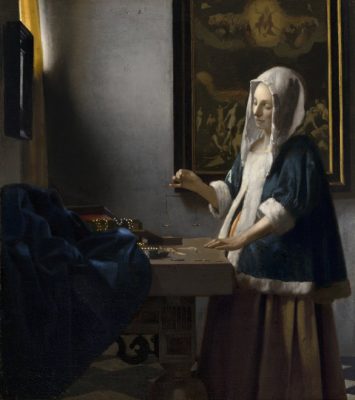Only about 35 paintings by Johannes Vermeer are known today. The National Gallery owns four works by or attributed to this beloved 17th-century Dutch artist: Woman Holding a Balance, A Lady Writing, Girl with the Red Hat, and Girl with a Flute.
Vermeer’s Secrets will offer visitors an inside look at how the National Gallery’s curators, conservators, and scientists work together to understand artists’ techniques, materials, and processes. In this instance, an intensive study of four paintings by and attributed to Johannes Vermeer yielded surprising information about the paintings which will be shared for the first time in the exhibition. The exhibition also includes two 20th-century forgeries, The Lacemaker (ca. 1925) and The Smiling Girl (ca. 1925), which were attributed to Vermeer when they first entered the museum’s collection in 1937 as part of Andrew Mellon’s original bequest, but were later determined not to be by the artist. Juxtaposing these two non-Vermeer works with paintings firmly attributed to the Dutch artist—Woman Holding a Balance (ca. 1664), A Lady Writing (ca. 1665), and Girl with the Red Hat (ca. 1666/1667)—will demonstrate how curators utilize research from a range of disciplines to evaluate works of art and determine attributions, as well as the qualities that make a Vermeer a Vermeer.
The exhibition incorporates vivid technical images made using innovative technologies pioneered by two leaders in the field of scientific imaging, the National Gallery’s senior imaging scientist John K. Delaney and imaging scientist Kathryn A. Dooley. Using hyperspectral reflectance imaging techniques first developed to map minerals for remote sensing of the earth and subsequently the moon and Mars, as well as X-ray fluorescence imaging spectroscopy, Delaney and Dooley are able to identify and map pigments and also reveal what lies beneath the surface of a painting. While earlier technical examination (magnified examinations of the paintings, analysis of microsamples, and X-ray fluorescence spot analysis) allowed Melanie Gifford and Lisha Glinsman to hypothesize the stages in Vermeer’s working methods, these advancements in imaging technologies provided the opportunity to try and visualize those stages. The resulting images allowed the team to analyze the distribution of pigments across the paintings, distinguish compositional changes, and in the case of the Girl with the Red Hat, reveal more details about an earlier unfinished bust-length portrait of a man with a wide-brimmed hat.
The exhibition is curated by Betsy Wieseman, curator and head, and Alexandra Libby, associate curator, department of Northern European painting, National Gallery of Art.
Conservation research and technical imaging at the National Gallery were provided by Dina Anchin, associate paintings conservator; John K. Delaney, senior imaging scientist; Kathryn A. Dooley, imaging scientist; E. Melanie Gifford, conservation scientist (retired); and Lisha Deming Glinsman, conservation scientist (retired).

National Gallery of Art, Washington, DC.
[text via codart.nl]